★★½
“Slime of your life.”
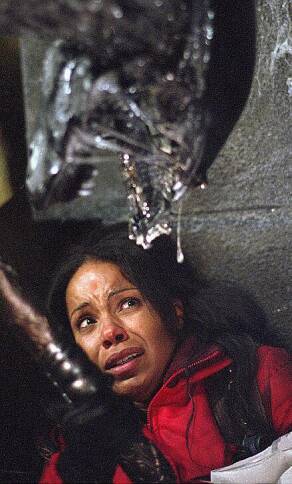 Initially inspired by a throwaway joke in Predator 2 – an alien skull in the Predator’s trophy cabinet – this has been some time in the making. Seven years have passed since the last entry in the Alien franchise, and fourteen since P2. Comics and video games have beaten the movie to the screen, and if truth be told, this film bears more resemblance to them than anything else. This is no surprise, given director Anderson helmed both Mortal Kombat and Resident Evil. Interestingly, it takes place pre-Alien, in the present day. A pyramid is discovered deep under the ice on an island near Antarctica; industrialist Charles Weyland (Henriksen) puts together a team to investigate, led by Alexa (Lathan), the kind of lady who free-climbs ice-walls for kicks. They soon find that the pyramid is a training compound where, every 100 years, the Predators come to hunt aliens, with humans hosts for the acid-blooded critters
Initially inspired by a throwaway joke in Predator 2 – an alien skull in the Predator’s trophy cabinet – this has been some time in the making. Seven years have passed since the last entry in the Alien franchise, and fourteen since P2. Comics and video games have beaten the movie to the screen, and if truth be told, this film bears more resemblance to them than anything else. This is no surprise, given director Anderson helmed both Mortal Kombat and Resident Evil. Interestingly, it takes place pre-Alien, in the present day. A pyramid is discovered deep under the ice on an island near Antarctica; industrialist Charles Weyland (Henriksen) puts together a team to investigate, led by Alexa (Lathan), the kind of lady who free-climbs ice-walls for kicks. They soon find that the pyramid is a training compound where, every 100 years, the Predators come to hunt aliens, with humans hosts for the acid-blooded critters
It’s a totally ludicrous concept. The Alien life-cycle, from hatching, through infection and chest-bursting, to full-sized monsterhood, is now ridiculously fast. In an idea lifted from Cube, the pyramid floor-plan changes configuration precisely every ten minutes – even though the “minute” wasn’t invented (by the Babylonians, fact fans) when this supposedly “first pyramid” was built. And expending such effort on a stadium used a couple of hours per century is wildly implausible.
There’s never any doubt who the stars are here, and it’s not the humans, who engage in such cliched behavious as showing photos of their kids – which, as we all know, is a death sentence in this kind of film. In addition, they persist in using hand-held flares when they possess perfectly good flashlights, for no reason other than to create spooky shadows. Alexa’s bilingual sidekick Sebastian (Bova) is intensely irritating in both English and Italian, but fortunately the heroine herself makes a decent impression, improving as the film goes on in much the same way as Ripley did in the original. Of course, Lathan is not Sigourney Weaver – but neither was Weaver when she started. [Er, if you see what I mean…]
The film steps up towards the end, finally delivering what we all came to see: full-on, three-way carnage, climaxing in Alexa + Predator vs. the Alien Queen. I’d be lying if I didn’t say this was cool, and the thought crossed my mind: with two of the three combatants being female, is the Predator perhaps one too? If so, this would probably be the ultimate in brawlin’ broads. However, the best moment is actually a flashback to an earlier cycle, with the Predators atop a pyramid, up which thousands of Aliens are swarming. It makes you wish they’d dropped us altogether and just let the titular twosome go at it, head-on.
There are a couple of nice nods to the inspirations, such as Lance Henriksen’s presence in the cast, albeit not playing an android this time. Alexa at one point almost echoes Arnie’s line, “You’re one ugly motherfucker!”, though doesn’t get to complete it, thanks to the film’s PG-13 rating. It’s hard to deny the toning-down this requires hampers the production, limiting the amount of violence that can be done (to the humans, at least – on both Alien and Predator planets, this would likely still be rated R). The effects are mostly adequate to well-done, though Anderson’s style is to cut fast rather than linger so we could give them any scrutiny.
The end result is a disappointment that works better as a high concept than on the screen. 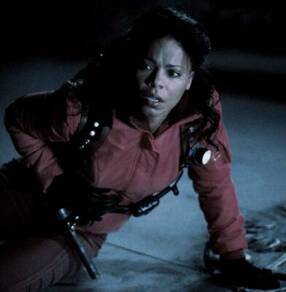 Part of the problem is that we’re never given any reason to root for anyone, from anywhere in the universe. The Aliens are the villains, who must be contained at any cost – fair enough. However, the Predators are equally opaque, and most of the human characters are a far cry from, say, Aliens‘ marine corps. Sure, they were sterotypes, but they proved you could quickly create endearing and memorable characters with well-chosen dialogue. In contrast, there are few memorable lines to be found here. Indeed, few moments will stick in your mind at all – and when they do, you may find yourself wishing they had slid right on past, such as the moment where a facehugger suddenly enters The Matrix. Hey, now there’s an idea for a crossover: Neo and Trinity take on the extra-terrestrials. Quick, where’s my typewriter?
Part of the problem is that we’re never given any reason to root for anyone, from anywhere in the universe. The Aliens are the villains, who must be contained at any cost – fair enough. However, the Predators are equally opaque, and most of the human characters are a far cry from, say, Aliens‘ marine corps. Sure, they were sterotypes, but they proved you could quickly create endearing and memorable characters with well-chosen dialogue. In contrast, there are few memorable lines to be found here. Indeed, few moments will stick in your mind at all – and when they do, you may find yourself wishing they had slid right on past, such as the moment where a facehugger suddenly enters The Matrix. Hey, now there’s an idea for a crossover: Neo and Trinity take on the extra-terrestrials. Quick, where’s my typewriter?
Dir: Paul W.S. Anderson
Star: Sanaa Lathan, Raoul Bova, Lance Henriksen, Ewan Bremner

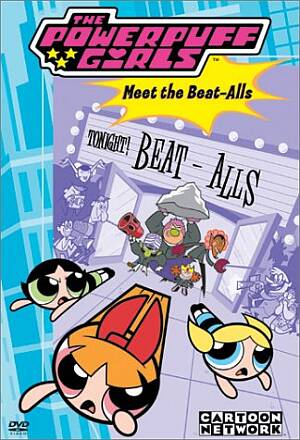 This sprang virtually fully-formed from the twisted mind of McCracken back in 1992, as a student film: even then, he intended it as a series, with most the characters, both heroines and villains, already present. The main change was to the title, the Cartoon Network balking at presenting a show called The Whoop-Ass Girls, and so the “can of whoop-ass” which was originally part of their make-up, was replaced by Chemical X.
This sprang virtually fully-formed from the twisted mind of McCracken back in 1992, as a student film: even then, he intended it as a series, with most the characters, both heroines and villains, already present. The main change was to the title, the Cartoon Network balking at presenting a show called The Whoop-Ass Girls, and so the “can of whoop-ass” which was originally part of their make-up, was replaced by Chemical X.




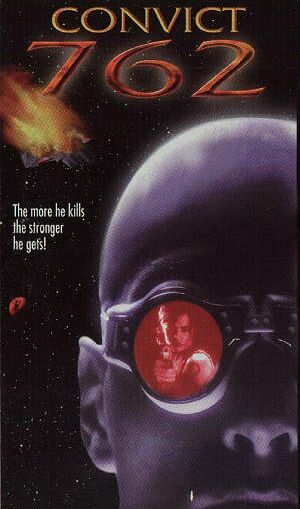 A good idea – even if one borrowed about equally from Pitch Black and Aliens – gets sucked into the void and drained of all life, thanks to some of the most turgid direction imaginable. A ship with an all-female crew has to land on a prison planet for fuel, but finds only two people left. Which is the mass murderer? Can they find out before they get picked off, one by one…?
A good idea – even if one borrowed about equally from Pitch Black and Aliens – gets sucked into the void and drained of all life, thanks to some of the most turgid direction imaginable. A ship with an all-female crew has to land on a prison planet for fuel, but finds only two people left. Which is the mass murderer? Can they find out before they get picked off, one by one…? After thirty minutes, I was toying with the idea of giving this the first ever 0 star rating. On that basis, eventually creeping up to two counts as something of a miraculous recovery. The heroine is an alien, transporting her child across the English countryside, while being pursued by white-masked hunters. There is almost no dialogue, which is so obviously a penny-pinching device it hurts – the video stock and woeful “martial arts” don’t help.
After thirty minutes, I was toying with the idea of giving this the first ever 0 star rating. On that basis, eventually creeping up to two counts as something of a miraculous recovery. The heroine is an alien, transporting her child across the English countryside, while being pursued by white-masked hunters. There is almost no dialogue, which is so obviously a penny-pinching device it hurts – the video stock and woeful “martial arts” don’t help.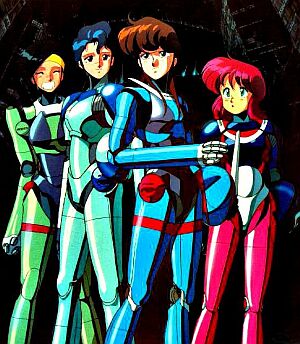 Worthy of note as one of the first pieces of anime made available to an English-speaking audience, (not long after its original 1985 Japanese release), BGC is set in 2032, when Tokyo has been rebuilt, post-earthquake. The Genom corporation are fiddling with Boomers, biomechanical robots of immense strength but with a nasty tendency to run amok. Standing guard are a mysterious team, the Knight Sabers, with their own technological strengths, who alternate between merc work and more altruistic concerns.
Worthy of note as one of the first pieces of anime made available to an English-speaking audience, (not long after its original 1985 Japanese release), BGC is set in 2032, when Tokyo has been rebuilt, post-earthquake. The Genom corporation are fiddling with Boomers, biomechanical robots of immense strength but with a nasty tendency to run amok. Standing guard are a mysterious team, the Knight Sabers, with their own technological strengths, who alternate between merc work and more altruistic concerns.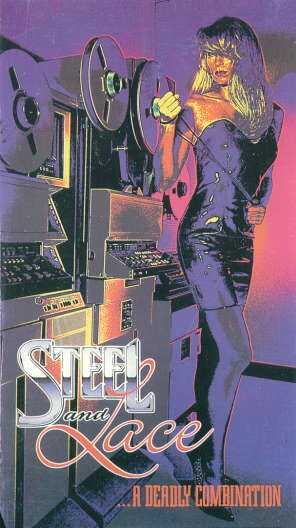 Inside ten minutes, we’ve had heroine Gaily Morton (Wren) raped and her attackers acquitted in court, not to mention her subsequent leap off a roof-top to her death – this isn’t a film which hangs around, boys and girls. Luckily, her brother is a NASA boffin (Davison – you might recognise him as the Senator from X-Men), who builds a robot in her image, in order to wreak gory revenge on the perpetrators five years later. Cleaning up behind are a cop (Naughton) and his ex-girlfriend, a courtroom artist (Haiduk) who joins the dots.
Inside ten minutes, we’ve had heroine Gaily Morton (Wren) raped and her attackers acquitted in court, not to mention her subsequent leap off a roof-top to her death – this isn’t a film which hangs around, boys and girls. Luckily, her brother is a NASA boffin (Davison – you might recognise him as the Senator from X-Men), who builds a robot in her image, in order to wreak gory revenge on the perpetrators five years later. Cleaning up behind are a cop (Naughton) and his ex-girlfriend, a courtroom artist (Haiduk) who joins the dots.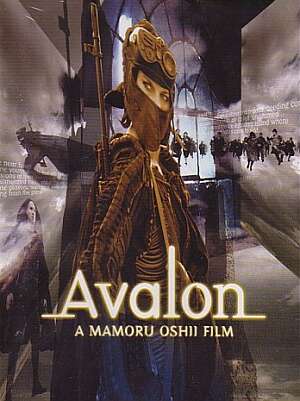 While this is live-action, Oshii is best known for his anime work, such as Ghost in the Shell. That also had an action heroine, great visual style and lost its way in philosophical navel-gazing. There, it was the nature of self – here, it’s the nature of reality. Set in Poland, which may be a first for a Japanese film, the heroine, Ash (Foremniak), is addicted to an illegal computer game called Avalon. When she hears about the existence of a special level in it, she’ll stop at nothing to find the entrance. But, for her, the line between life and pastime is becoming more and more blurred…
While this is live-action, Oshii is best known for his anime work, such as Ghost in the Shell. That also had an action heroine, great visual style and lost its way in philosophical navel-gazing. There, it was the nature of self – here, it’s the nature of reality. Set in Poland, which may be a first for a Japanese film, the heroine, Ash (Foremniak), is addicted to an illegal computer game called Avalon. When she hears about the existence of a special level in it, she’ll stop at nothing to find the entrance. But, for her, the line between life and pastime is becoming more and more blurred…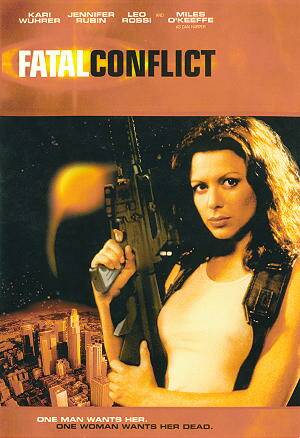 Wuhrer plays Sasha, a space pilot coerced into attempting to stop a rocket, hijacked by evil emerald dealer Conrad Nash (Rossi) and his creepily incestuous sister Carla (Rubin), from ploughing into LA. The proper pilot (O’Keefe) provides assistance, with much running around corridors and plunging into a glycerine tank. Yes, glycerine: a feeble excuse to give our heroine the wettest T-shirt of all time. Between this and the “ass panning” (as Chris described Simandl’s fondness for shooting at waist level), it seems disturbingly fetishistic, though a large chunk is due to footage spliced in from another movie – see
Wuhrer plays Sasha, a space pilot coerced into attempting to stop a rocket, hijacked by evil emerald dealer Conrad Nash (Rossi) and his creepily incestuous sister Carla (Rubin), from ploughing into LA. The proper pilot (O’Keefe) provides assistance, with much running around corridors and plunging into a glycerine tank. Yes, glycerine: a feeble excuse to give our heroine the wettest T-shirt of all time. Between this and the “ass panning” (as Chris described Simandl’s fondness for shooting at waist level), it seems disturbingly fetishistic, though a large chunk is due to footage spliced in from another movie – see 
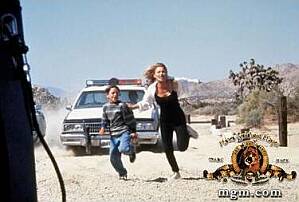 Our qualms were largely because, unlike Run Lola Run or Groundhog Day, which made no attempt to explain what was happening, here there’s just enough logic to be unsatisfying. The “rules” are clearly important – for example, do time-travellers keep their memories? – yet are inadequately laid out. We spent the last 15 minutes with furrowed brows, trying to see if it made sense. It may, or may not, but either way was an unwelcome diversion in an otherwise pleasant surprise.
Our qualms were largely because, unlike Run Lola Run or Groundhog Day, which made no attempt to explain what was happening, here there’s just enough logic to be unsatisfying. The “rules” are clearly important – for example, do time-travellers keep their memories? – yet are inadequately laid out. We spent the last 15 minutes with furrowed brows, trying to see if it made sense. It may, or may not, but either way was an unwelcome diversion in an otherwise pleasant surprise. Initially inspired by a throwaway joke in Predator 2 – an alien skull in the Predator’s trophy cabinet – this has been some time in the making. Seven years have passed since the last entry in the Alien franchise, and
Initially inspired by a throwaway joke in Predator 2 – an alien skull in the Predator’s trophy cabinet – this has been some time in the making. Seven years have passed since the last entry in the Alien franchise, and  Part of the problem is that we’re never given any reason to root for anyone, from anywhere in the universe. The Aliens are the villains, who must be contained at any cost – fair enough. However, the Predators are equally opaque, and most of the human characters are a far cry from, say, Aliens‘ marine corps. Sure, they were sterotypes, but they proved you could quickly create endearing and memorable characters with well-chosen dialogue. In contrast, there are few memorable lines to be found here. Indeed, few moments will stick in your mind at all – and when they do, you may find yourself wishing they had slid right on past, such as the moment where a facehugger suddenly enters The Matrix. Hey, now
Part of the problem is that we’re never given any reason to root for anyone, from anywhere in the universe. The Aliens are the villains, who must be contained at any cost – fair enough. However, the Predators are equally opaque, and most of the human characters are a far cry from, say, Aliens‘ marine corps. Sure, they were sterotypes, but they proved you could quickly create endearing and memorable characters with well-chosen dialogue. In contrast, there are few memorable lines to be found here. Indeed, few moments will stick in your mind at all – and when they do, you may find yourself wishing they had slid right on past, such as the moment where a facehugger suddenly enters The Matrix. Hey, now 
 I imagine no-one genuinely doubts the answer, but this adds a whole new plot twist, especially as the last time the Mongoose activated his weapon, its impact was pretty heavy. What happens when it’s used here is never really shown, and there is some scientific handwaving about the black hole absorbing all the energy, but it would be gratifying to think that it became necessary to destroy the city in order to save it. Not least because Cameron’s Dark Angel
I imagine no-one genuinely doubts the answer, but this adds a whole new plot twist, especially as the last time the Mongoose activated his weapon, its impact was pretty heavy. What happens when it’s used here is never really shown, and there is some scientific handwaving about the black hole absorbing all the energy, but it would be gratifying to think that it became necessary to destroy the city in order to save it. Not least because Cameron’s Dark Angel